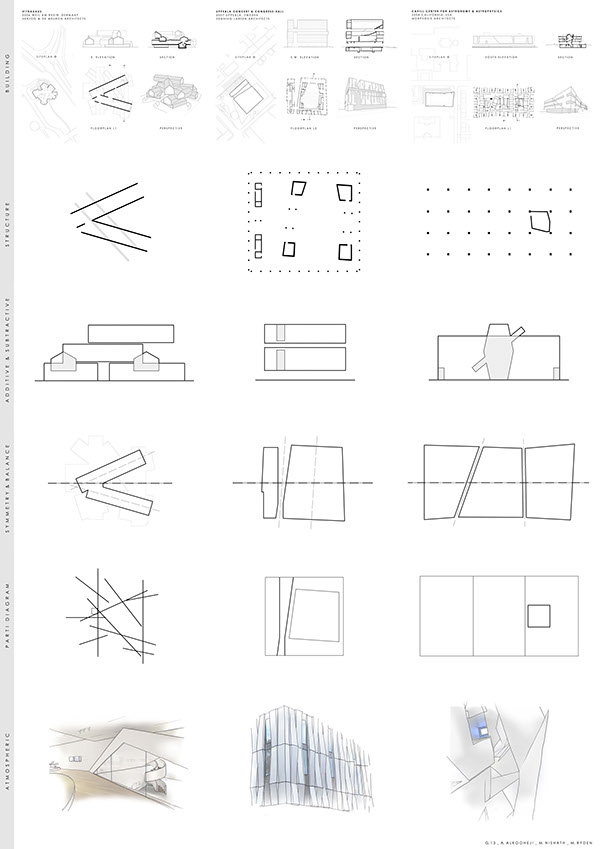PRECEDENT STUDIES
The study ofarchitectural precedent is a time-honoured way of learning how to respond tothe continual challenges posed by the need to create appropriate settings forhuman habitation. It remains a useful andpopular educational tool in schools of architecture throughout the world.
In a group of three, we are to prepare a drawn comparative analysis of the buildings selected each member, in which special attention is paid to five aspects included in the following list of design criteria (what we picked): Elements (structure), Relationships (additive to subtractive),Ordering principles (symmetry and balance), Parti (the essential formal statement) and Atmospheric (perspective). The emphasis falls on the ability to distill the core design concepts of a building or an urban space, assessing their efficacy in relation to the general project objectives, taking account of context, and conveying the findings simply and clearly by visual means.
The aim of this exercise is to employ a particulargraphic methodology to interpret and communicate the formal compositionalstructure of three single buildings of choice, in a comparative manner. The exercise is about saying the most withthe least amount of 2D drawing in black & white (only Atmoshperic can have 3D images and colour, and words should be keptto a minimum). Every nuance, every variation in linethickness counts; the skill lies in prudent selection and precision inpresentation. Or in other words, sayingmore with less.
The three buildings selected were the Vitrahaus by Herzogand De Meuron Architects, Uppsala Concert and Congress Hall by Henning LarsenArchitects and Cahill Center for Astronomy and Astrophysics by MorphosisArchitects (my selection).
In a group of three, we are to prepare a drawn comparative analysis of the buildings selected each member, in which special attention is paid to five aspects included in the following list of design criteria (what we picked): Elements (structure), Relationships (additive to subtractive),Ordering principles (symmetry and balance), Parti (the essential formal statement) and Atmospheric (perspective). The emphasis falls on the ability to distill the core design concepts of a building or an urban space, assessing their efficacy in relation to the general project objectives, taking account of context, and conveying the findings simply and clearly by visual means.
The aim of this exercise is to employ a particulargraphic methodology to interpret and communicate the formal compositionalstructure of three single buildings of choice, in a comparative manner. The exercise is about saying the most withthe least amount of 2D drawing in black & white (only Atmoshperic can have 3D images and colour, and words should be keptto a minimum). Every nuance, every variation in linethickness counts; the skill lies in prudent selection and precision inpresentation. Or in other words, sayingmore with less.
The three buildings selected were the Vitrahaus by Herzogand De Meuron Architects, Uppsala Concert and Congress Hall by Henning LarsenArchitects and Cahill Center for Astronomy and Astrophysics by MorphosisArchitects (my selection).


